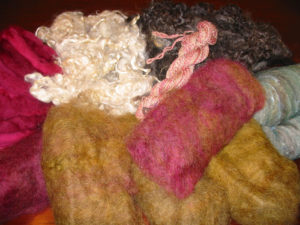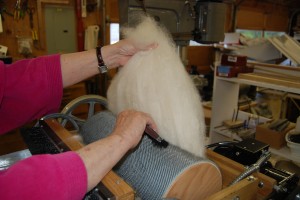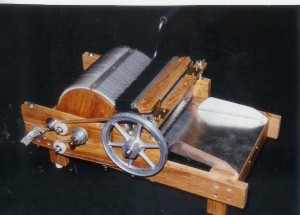 Fiber Selection and Preparation
Fiber Selection and Preparation
Low quality or poorly prepared fiber will yield an inferior product even after thorough carding. The highest quality fiber consistent with the use (knitting, felting, weaving fabric, weaving rugs, etc.) should be selected for carding. The fiber should be thoroughly washed, rinsed and dried before it is carded. Prior to carding with the hand crank drum carder, the locks of wool, mohair, or any tight or matted material should be opened up by picking and teasing to separate the fibers. A picking machine can also be used for this purpose but care should be taken to insure that the fibers are not torn or broken by this process.
Carding
When the fiber is ready to card, the carder is operated by turning the hand crank forward (clockwise). The small drum or licker, will turn in the opposite direction (counter clockwise) from the large drum. The fleece will be fed under the licker and into the teeth of the large drum. Carding takes place when the fiber is held by the teeth of the small drum (the small drum revolves five times slower than the large drum) and is caught, stretched, and held in the teeth of the large drum forming a batt that can be broken into strips and spun. Carding parallel and well opened fibers helps prevent breakage and pilling of the fibers. This is especially important with very fine fleece such as Columbia, Rambouillet, Merino, etc. If these finer fibers catch sideways in the card cloth wires, they can be broken and pill. Before carding cotton, cashmere or any fine short fiber, try filling the large drum ½ to ¾ full with wool before carding the short fibers. The wool will keep the short fibers from sinking into the card teeth. The top layer of short fibers should separate easily from the wool batt.
Carding Fine, Low Crimp, and Fluffy Fibers with the Duncan Fine Fiber Brush
We have patented a device which we call the “Fine Fiber Brush” that enhances the Duncan’s and other makes of carders ability to card Mohair, Angora Rabbit, Cashmere, Alpaca, Llama and other fine and fluffy fibers. This unit consists of a special weighted brush that holds the fibers into the teeth of the large drum and simultaneously comb and straightens the fibers as the batt is built up and prevents feedback and build up of fibers on the small licker-in drum. As the weighted brush combs through the card teeth, all fiber accumulating on the large drum is continuously exposed to this combing/brushing action. When a batt is complete, the brush hinges off the large drum to allow doffing of the batt. The Fine Fiber Brush should be used with all fibers to insure a more uniform and condensed batt. The Fine Fiber Brush can be installed on all Duncan Carders in minutes. Brush mounting kits have also been developed for several other makes of carders. In most cases, the Fine Fiber Brush eliminates the need for interchangeable drums when carding the fine, low crimp, fluffy fibers.
 Batt Removal
Batt Removal
When the fiber has filled the teeth on the large drum (you will know because the fiber will begin to transfer back to the small drum), the batt should be removed. The batt is removed by tearing a strip across the batt using a doffer, an ice pick or other device separating the fibers across the aluminum strip in the opening in the card teeth. The batt is stripped out of the teeth by turning the large drum backwards (counter clockwise) while holding and lifting the batt. A doffing brush (which we sell) can be used to help lift the batt out of the teeth and clean stray fibers out of the teeth as the batt is removed. If the fiber is sufficiently carded, the process is finished. However, we have found that stripping the batt apart and running it through the carder one or more times yields a better batt for spinning. Fine wools should be fed into the carder so that they are pulled straight onto the large drum. Care must be taken with fine fleeces such as Marino, that fibers are not broken and pilled by filling the teeth too full or carding too many times. Usually two or three times through the carder is enough for most fleeces.
Carding With Motorized Carders
Carding with a Duncan motorized carder is similar to the hand crank carder with a few important differences. The fleece usually does not have to be extensively teased or picked prior to carding. The first run through the carder will open up all but the most matted fleece. Additional cardings are both easy and rapid as the machine does the work as the operator feeds the partially carded batts into the machine. It is best to strip sections off the batt and feed them evenly across the drums. This method produces a fully carded and well blended batt. Batts are removed from the motorized carder by tearing a strip access the large drum and turning the drum backwards (counter clockwise) using the hand wheel on the left side of the carder. CAUTION: Care should be taken to insure that fingers, hair, and loose clothing are not caught by the card teeth when the motorized carder is running. Children should not be allowed to play with or touch the moving parts of the machine when it is operating.
Care and Maintenance
Duncan carders are designed and constructed to require very little maintenance or adjustment. However, it is important to occasionally remove any fiber that has wound around the drum shafts. If fiber is allowed to build up and compress between the drum end and the bearing blocks, the bearings can be pushed out of the blocks. Preferably only clean, dry fleece should be carded. Fleece carded “in the grease” will gum-up the card cloth and lanolin will be transferred to any clean fleece carded later. An occasional drop of machine oil, or general household oil dropped into the bearings can be beneficial if the carder is cranking hard, however, the bearings are graphite impregnated and do not usually require oiling. The card teeth are hardened steel but are not stainless or rust proof. The teeth should not be left damp or wet for extended periods. All metal parts should be wiped with a lightly oiled rag prior to storing the carder for any length of time; this is especially important in coastal areas or damp climates. IMPORTANT! The carder should not be left in direct, hot sunlight outdoors or in a window. Expansion and dehydration can cause warpage of the wooden drums. When the carder is not being used for extended periods, the round licker-in drive belts should be loosened to prevent excessive stretching.
Adjusting Drum Spacing
Normally the drum spacing should not require adjusting unless the fiber will not card properly with the original spacing. The drum spacing as originally set will card most fibers correctly. Mohair and Angora, which do not have significant crimp like wool, will benefit from the use of the Fine Fiber Brush.
To adjust the drum spacing, the nuts on the hold down bolts of the long front bearing blocks must be loosened so the blocks can slide. The nuts on the diagonal drum spacing arms can then be alternately loosened and tightened to increase or decrease the spacing between the drums. Correct spacing is about the thickness of a credit card. The teeth should not touch or scrape against the feed pan or themselves. When the desired spacing is achieved, all nuts must be tightened before resuming carding.
 Cleaning
Cleaning
Cleaning the carder takes time. To save time, you can allow the fibers to build up on the small drum. These fibers are usually “second cuts” or very short pieces of fleece that are not long enough to be caught by the teeth of the large drum. It is quicker to clean leftover fleece off the next batt than to take the time to clean the large drum between fibers or colors. After the second or third batt, little or no residual fibers should come off. Try to clean all of the batt off the drum so there are no areas that build up fibers faster than others. We make and use a “Doffing Brush” to help clean the large drum. Run the carder until all the fleece that will come off the small drum is transferred to the large drum. Clean the large drum thoroughly and leave whatever fiber remains on the small drum.
Drive Belt Configuration
The following photograph shows the correct configuration of the round licker-in belt around the drive pulleys and idler sheaves for all Duncan carders. The 16” wide models have these drives on both sides of the carder. The 8” models have the drive on the left side of the machine.
To install:
- Lay one end of the belt around the shaft that is attached to the big pulley on the end of the small, licker-in drum. (See the big black arrow.) Make sure the belt is on the inside of the big pulley, next to the wood.
- Wrap the belt around #1, #2, then #3 on the picture.
- Pick up the belt from step 1 above. Lay it in the groove of the big pulley (see the small arrow). Hold it here and rotate the big drum. The belt will snap into place as you roll.
General
Do not hesitate to try out different methods or procedures to get the desired results from carding different fleeces or other types of fibers. The basic drum carder is a simple machine that is designed to help the spinner or felter prepare the fleece, not to replace the human in the process. The final product will be the result of your judgment. The carder will help you produce a workable product faster, but you can produce the same results with your fingers or hand tools if you are willing to take the time.
Safety Rules for Power Carders
- Keep guards in place and good working order. If guards are removed to adjust drum spacing or change belts, replace the guards before operating the carder.
- Ground the carder motor. The electrical cord supplied with the carder has a three prong (grounded) plug. This plug should only be inserted into a three-hole grounded receptacle. If an adapter is used to accommodate a two prong outlet, the adaptor plug must be attached to a known ground. NEVER remove the third (ground) prong.
- Remove adjusting keys and wrenches. Form the habit of checking to see that wrenches and other tools are removed from the carder before turning it on.
- Keep the work area clean. Cluttered areas and benches invite accidents. Do not let loose fleeces, batts, clothing or other materials that you do not want to run through the carder accumulate around the carder.
- Avoid a dangerous environment. Don’t use the carder in damp or wet locations. Keep your work area well illuminated.
- Keep visitors away while the carder is operating. All visitors should keep a safe distance from the work area.
- Make the work area “child proof”. Do not let children play around the carder while it is operating. Insure that the carder cannot be operated when it is unattended by unplugging the cord, turning off the master switches and locking the doors to the work area.
HELP
Any comments or suggestions that might make these instructions more clear or comprehensive are welcome. They are essential to our policy of continually upgrading our products and knowledge.
Go to the Features Page for more details on Duncan Carders.
Go back to the Duncan Carders page.
Go to our Store Page for information on ordering your Duncan Carder.
